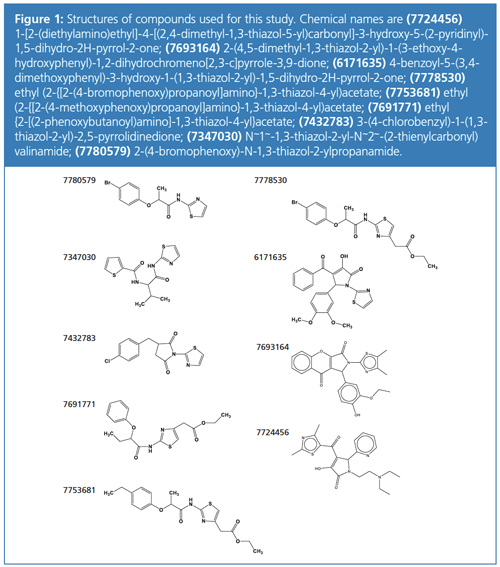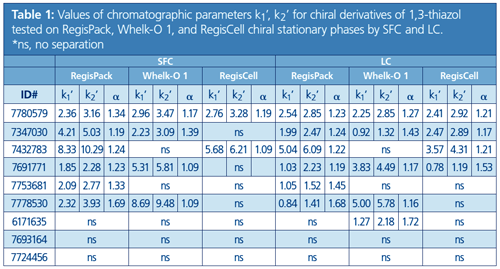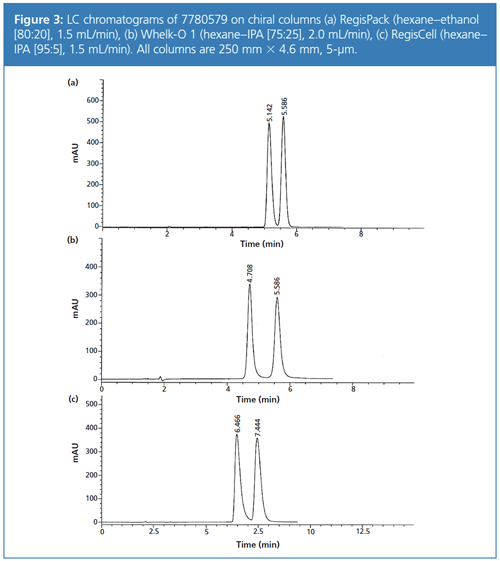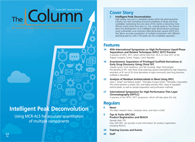Enantiomeric Separation of Privileged Scaffold Derivatives in Early Drug Discovery Using Chiral SFC
The Column
Successful therapeutic intervention often requires chiral medicines because of the intrinsic chirality of protein drug targets, which consist of L-amino acids. Potency, efficacy, and safety can be highly dependent on the precise stereochemical geometry of the molecules. Determining the biological profile of individual enantiomers in the early stages of drug discovery is important for successful optimization towards clinical candidates. Here we demonstrate the benefits of supercritical fluid chromatography (SFC) with three chiral stationary phases exemplified by high frequency resolution of 41 out of 50 chiral derivatives of eight commonly used drug discovery scaffolds including 1,3-thiazoles, 1,3-benzothiazoles, pyranoquinolones, indoles, and leucolines.
Photo Credit: style_TTT/Shutterstock.com

Claude Lerner, Scott Anderson, and Ted Szczerba, Regis Technologies, Morton Grove, Illinois, USA
Successful therapeutic intervention often requires chiral medicines because of the intrinsic chirality of protein drug targets, which consist of L-amino acids. Potency, efficacy, and safety can be highly dependent on the precise stereochemical geometry of the molecules. Determining the biological profile of individual enantiomers in the early stages of drug discovery is important for successful optimization towards clinical candidates. Here we demonstrate the benefits of supercritical fluid chromatography (SFC) with three chiral stationary phases exemplified by high frequency resolution of 41 out of 50 chiral derivatives of eight commonly used drug discovery scaffolds including 1,3-thiazoles, 1,3-benzothiazoles, pyranoquinolones, indoles, and leucolines.
Early stage drug discovery often involves high throughput screening (HTS) of large collections of small molecules to identify compounds with desired biochemical and cellular activities. Such molecules are called HTS “hits”, which then undergo “hitâtoâlead” analysis where they are triaged by their synthetic tractability and activity in panels of cellular and biochemical assays. Structural analogs, often from the screening collection, are also tested and characterized together as a group in a process known as lead discovery. Groups of analogs showing desirable patterns of activity become known as a lead series and are selected for lead development, whereby medicinal chemistry is used to create a large series of structural analogs to evaluate the effects of structural changes on biological activity and develop what is known as structure activity relationships (SAR). Wellâdefined SAR enables prediction of the effects of structural changes and provides paths to synthetic strategies for the next stage, lead optimization. At this stage, large numbers of analogs are synthesized and tested to craft a promising lead compound that can be moved forward into more advanced testing including animal model and preclinical toxicology studies.
The early drug discovery process is resource-intensive, and for a variety of reasons many HTS hits do not progress very far. Medicinal chemistry resources are critical to success and often in great demand, especially when a strong candidate emerges and intense synthetic efforts are needed to identify a promising clinical candidate. Therefore, the hundreds to thousands of molecules emerging from HTS screening need to be efficiently prioritized and vetted. Filters are used to hone the numbers down to manageable quantities and one filter is chirality. Unlike achiral hits that consist of a single molecule, chiral hits consist of two enantiomers that can have dramatically different biological activity. As such, assay data for chiral mixtures is clouded by the activity of both molecules and thus does not reflect the activity of the individual enantiomers. Therefore, chiral hits are best studied as individual enantiomers, which require the additional step of preparative separation. Statistics from the marketplace offer compelling reasons to invest in this extra effort. For example, of the 30 topâselling drugs in 2014, 40% were chiral, while only 13% were achiral (the remaining 47% were therapeutic proteins or antibodies [1]). Similarly, of the 40 most promising clinical candidates that were in development in 2016, more than 38% were chiral (2).
To address the need to purify chiral molecules at early stages of drug discovery, many large pharmaceutical companies have developed in-house capabilities for chiral separations (3,4). However, smaller companies can lack the necessary resources and may have to rely on outside organizations and expertise.
In the work discussed here, we assess the success rate of performing chiral separations at the earliest “hit-to-lead” stage of drug discovery research. “Hit compounds” identified in HTS screens are often from libraries of small molecules available commercially from specialized companies that support small molecule drug discovery research. To mimic this process, we used the same source of compounds for our study. The compounds were screened by supercritical fluid chromatography (SFC) for developing preparative purification methods, and by high performance liquid chromatography (HPLC) in cases where SFC did not provide adequate separation and for the purpose of analyzing purity post-purification. Three of the top classes of chiral stationary phases were screened: coated polysaccharide phases with the widely used chiral selector Tris-(3,5-dimethylphenyl) carbamate bound to amylose or cellulose and a Pirkleâtype immobilized phase (5). To provide information on compounds most pertinent to drug discovery, we chose to screen a series of chiral derivatives of privileged scaffolds (6,7) including 1,3-thiazoles (8,9), indoles (10,11), 1,3,5-triazines (12), 1,3-benzothiazoles (13), pyranoquinolones (10), dihydroquinazolinones (14), Pyranoquinolones (14), and leucolines (13).
Experimental
Thirty-nine drug discovery scaffolds were identified by on-line literature searches to find compounds most similar to those historically used for drug discovery. The compounds were obtained from a small molecule screening library (Chembridge). The chemical informatics team at the company identified a subset of 59,358 compounds that had a single chiral centre and at least 20 mg of compound available. They then further filtered the list by molecular weight (300 to 450), cLogP of 0–4 for solubility in mobile phase solvents. They were also filtered by availability of nuclear magnetic resonance (NMR) data, which allows for structure confirmation of compounds that failed to separate, and therefore support the probability the results were true negatives. This yielded a subset of 14,654 compounds.
Substructure searches with the 39 scaffolds were performed at the company’s database screening web page (www.hit2lead.com). The searches yielded a total of 120,906 compounds. A subset of 2299 compounds were found to be common in both (120,906 ∩ 14,654). They were identified using an on-line list comparison tool (http://jura.wi.mit.edu/bioc/tools/compare.php, Bioinformatics and Research Computing, Whitehead Institute for Biomedical Research). The list of 2299 compounds was further refined using published criteria on oral bioavailability of drug candidates (15) and other characteristics of drug-like molecules (16,17), narrowing the cLogP filter to 0.76–3.97, restricting the number of rotatable bonds to 0–8, hydrogen bond acceptors to 2–7, and hydrogen bond donors to 0–4. This yielded a manageable list from which 50 compounds were selected for analysis.
SFC screening was done on a Thar Waters SFC Method Station and LC screening was done using an Agilent 1100 system. The RegisPack, RegisCell, and Whelk-O 1 columns (Regis Technologies) were all 250 mm × 4.6 mm, packed with 5-µm particles.
Results
Of the 50 chiral compounds from the eight scaffold classes, 41 could be enantiomerically resolved on one or more of the three chiral columns. Since the dataset is large, we focus here on a set of nine chiral derivatives of 1,3-thiazole (7) as a representative example of the study (Figure 1). Of the nine thiazoles, six were found to separate on at least one column (Table 1). Each of the six separated on the amylose phase by both SFC and LC, four of the six on the Pirkle phase by SFC and LC, and two of the six on the cellulose phase by SFC and four by LC. Of the six that could be separated, five separated by both SFC and LC on exactly the same columns. Of the nine thiazoles tested, seven separated by LC on one of the three columns, meaning one additional compound that could not be separated by SFC was able to be resolved on a Pirkle phase column by LC. The amylose phase had the broadest spectrum of selectivity towards these compounds followed by the Pirkle phase and then the cellulose phase. Figures 2 and 3 show example separations with compound 7780579, which separated on all columns by SFC and LC. By using these three complementary chiral stationary phases, an orthogonal approach towards separation can be applied to improve the chiral separation success rate.




Conclusion
Results from using a sample size of 50 compounds from eight classes of privileged scaffolds suggest that the majority (> 80%) of chiral compounds from early drug discovery HTS screens can be separated into their individual enantiomers by SFC using only three chiral stationary phases. This is good news considering an increasing number of marketed drugs are chiral. The ability to move forwards rapidly with chiral separations at this early stage of drug discovery holds promise for further success of HTS derived clinical candidates (18). By using complementary phases, an orthogonal approach towards separation can be applied to improve the success rate of chiral separations. Utilizing this approach early in the process at the HTS stage and focusing on separation of scaffold cores should allow researchers to get an early indication of chiral separation possibilities. Assessing the likelihood of chiral separation at an early stage will provide greater confidence and time to plan prior to “optimization” of the hit–lead compound. A parallel approach towards chiral screening and separation can then be applied during optimization phases, decreasing the need for purification development at later stages.
Acknowledgements
Chembridge Corporation technical support team and Melissa Wilcox and Kristine Biederer of Regis Technologies for assistance with the figures and manuscript.
References
- The Top 50 Drugs of 2014, C&EN Supplement (2014).
- Top 40 Drugs in the Pipeline – 2016, C&EN Supplement (2016).
- E.E. Jordan and P.A. Searle, American Pharmaceutical Review (2017). http://www.americanpharmaceuticalreview.com/Featured-Articles/335411-Supercritical-Fluid-Chromatography-An-Essential-Tool-in-Drug-Discovery/
- M. Wong, B. Murphy, J.H. Pease, and M.W. Dong, LCGC North America33, 402–413 (2015).
- C. Hamman, M. Wong, I. Aliagas, et al., J. Chromatogr. A. 1305, 310–319 (2013).
- H. Zhao and J. Dietrich, Expert Opin. Drug Discov.10, 781–790 (2015).
- M.E. Welsch, S.A. Snyder, and B.R. Stockwell. Curr. Opin. Chem. Biol.14, 347–361 (2010).
- A. Ayati, S. Emami, A. Asadipour, A. Shafiee, and A. Foroumadi, European Journal of Medicinal Chemistry 97, 699–718 (2015).
- C.B. Mishra, S. Kumari, and M. Tiwari, European Journal of Medicinal Chemistry92, 1–34 (2015).
- M.E. Welsch, S.A. Snyder, and B.R. Stockwell, Curr. Opin. Chem. Biol. 14, 347–361 (2010).
- M.J. Naim, O. Alam, M.J. Alam, et al., International Journal of Pharma Sciences and Research (IJPSR) 7, 51–62 (2016).
- Felicia Phei Lin Lima and Anton V. Dolzhenkoa, European Journal of Medicinal Chemistry85, 371–390 (2014).
- S.R. Langdon, N. Brown, and J. Blagg, J. Chem. Inf. Model.51, 2174–2185 (2011).
- K. Hemalath and G. Madhumith, European Journal of Medicinal Chemistry123, 596–630 (2016).
- D.F. Veber, S.R. Johnson, H.Y. Cheng, et al., Med Chem.6, 2615–2623 (2002).
- M.M. Hann and G.M. Keserü, Nature Reviews Drug Discovery11, 355–365 (2012).
- Giulio et al., Drug Discovery Today13(7–8), 285–294 (2008).
- R. Macarron, M.N. Banks, D. Bojanic, et al., Nat. Rev. Drug Discov.10, 188–95 (2011).
Claude Lerner is a Technical Sales Consultant for Chromatography and SFC Separations at Regis Technologies. He earned a B.S. in molecular biology at the University of Wisconsin at Madison, and a Ph.D. in biochemistry at the University of Illinois at UrbanaâChampaign. He has nearly 25 years of experience in drug discovery and protein diagnostics research and almost five years in sales of biotechnology and chemistry products and services. His current interests include providing chromatography and purification solutions to chemists and pharmacologists across a broad range of industries and academic institutions.
Ted Szczerba is the Technical Director of Chromatography and SFC Separations at Regis Technologies. He earned a B.S. in chemistry from the University of Illinois at UrbanaâChampaign. He has nearly 30 years of experience in chiral chromatography (including LC and SFC) applications and new product development including Restricted Access Media (RAM) columns for direct injection of small molecule analytes in complex biological matrices. His current interests are focused on advancing preparative SFC technology for chiral separations.
Scott Anderson is the Director of Chromatography and Separations at Regis Technologies. He earned a B.S. in biochemistry at Trinity International University. He has nearly 20 years of experience in chromatography product development and marketing. His current interests are focused on creating innovative solutions to help expedite drugs to market.
E-mail:scott.anderson@registech.comWebsite:www.registech.com

Thermodynamic Insights into Organic Solvent Extraction for Chemical Analysis of Medical Devices
April 16th 2025A new study, published by a researcher from Chemical Characterization Solutions in Minnesota, explored a new approach for sample preparation for the chemical characterization of medical devices.
Sorbonne Researchers Develop Miniaturized GC Detector for VOC Analysis
April 16th 2025A team of scientists from the Paris university developed and optimized MAVERIC, a miniaturized and autonomous gas chromatography (GC) system coupled to a nano-gravimetric detector (NGD) based on a NEMS (nano-electromechanical-system) resonator.
Miniaturized GC–MS Method for BVOC Analysis of Spanish Trees
April 16th 2025University of Valladolid scientists used a miniaturized method for analyzing biogenic volatile organic compounds (BVOCs) emitted by tree species, using headspace solid-phase microextraction coupled with gas chromatography and quadrupole time-of-flight mass spectrometry (HS-SPME-GC–QTOF-MS) has been developed.
A Guide to (U)HPLC Column Selection for Protein Analysis
April 16th 2025Analytical scientists are faced with the task of finding the right column from an almost unmanageable range of products. This paper focuses on columns that enable protein analysis under native conditions through size exclusion, hydrophobic interaction, and ion exchange chromatography. It will highlight the different column characteristics—pore size, particle size, base matrices, column dimensions, ligands—and which questions will help decide which columns to use.













